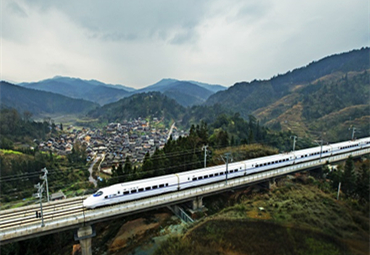Building firm foundations for progress

A view of the Pingtang Bridge in Southwest China's Guizhou province. [Photo/VCG]
Infrastructure achievements form integral part of nation's development
For 48-year-old Tan Lunbiao, a massive bridge in his village is not only a feast for the eyes but also a path to prosperity.
The fruit farmer of Pinglihe village in Southwest China's Guizhou province knows very well the positive impact of the link, right from the moment it opened to traffic.
"Before the bridge was built, transportation conditions were poor. It took a lot of time to transport fruit out and about 20 percent of our products turned rotten before they even reached the market. The bridge saved a lot of time and stemmed losses for local farmers," Tan said.
The bridge, with its main tower standing at 332 meters, shortens travel time to Guiyang, the provincial capital, from more than seven hours to two and a half.
Tan's annual income has hit over 50,000 ($6,950), more than double the amount before the bridge opened.
"Over the past 18 years, Guizhou has seen tremendous changes in its transportation network. And local residents have shaken off poverty and are now enjoying better lives. One important factor is the rapid development of transportation," said Li Zhao, chief engineer of the Fourth Branch of Guizhou Road and Bridge Group.
With more than 90 percent of its surface area being mountains and hills, Guizhou presents some of the most challenging conditions to develop a sound transportation system. It has been among the poorest provincial regions for many years.
"In many rural areas nationwide, especially those with harsh natural conditions, people only have access to very poor infrastructure," said Dong Yu, executive vice-president of Tsinghua University's China Institute for Development Planning.
Chinese authorities, recognizing that transportation is a key factor of sound development, have rolled out many measures through the decades to provide people with greater access to the links.
"China can pool resources together to accomplish major projects that are beneficial to national development and people's well-being," said Cai Tongjuan, a researcher from the Chongyang Institute for Financial Studies at Renmin University of China.
About 10 months after the Pingtang Bridge opened, another bridge construction project began in a valley about 250 kilometers to its northwest.
Building of the new Jinfeng Bridge, over the Wujiang River, required the joint efforts of 1,200 construction workers who overcame many hurdles in the project.
"When we first arrived, there was no water, electricity and well-built roads … The bridge project was tough and needed high-precision work," said Xie Qinjian, project manager with the Guizhou Road and Bridge Group. The bridge is set to open to traffic by the end of this year.
Nearly half of the world's 100 highest bridges are in Guizhou, according to industry figures. The scale of the province's total expressway network has nearly quadrupled over the past decade to stretch more than 8,000 km.
Guizhou's transportation inroads reflect China's broader infrastructure development.
"Infrastructure projects feature large investments and long cycles, thus requiring patience and persistence. Through the implementation of its five-year plans, China has ensured major projects are carried out consistently," Dong of Tsinghua University said.
Sourabh Gupta, a senior fellow at the Institute for China-America Studies, said China's infrastructure endeavors are rewriting the literature on development.
"China creates solid public sector assets and makes them really good assets. People will use that as a basis to improve their own lives," Gupta said.
京ICP备13028878号-8







 Overview
Overview Guiyang
Guiyang Guian New Area
Guian New Area Liupanshui
Liupanshui Anshun
Anshun Qianxinan
Qianxinan Qiandongnan
Qiandongnan Qiannan
Qiannan Zunyi
Zunyi Tongren
Tongren Bijie
Bijie Guizhou fosters cross-cultural bonds in Europe
Guizhou fosters cross-cultural bonds in Europe 18th Guizhou Tourism Industry Development Conference
18th Guizhou Tourism Industry Development Conference  Discover natural beauty in Qiannan, Guizhou
Discover natural beauty in Qiannan, Guizhou 

